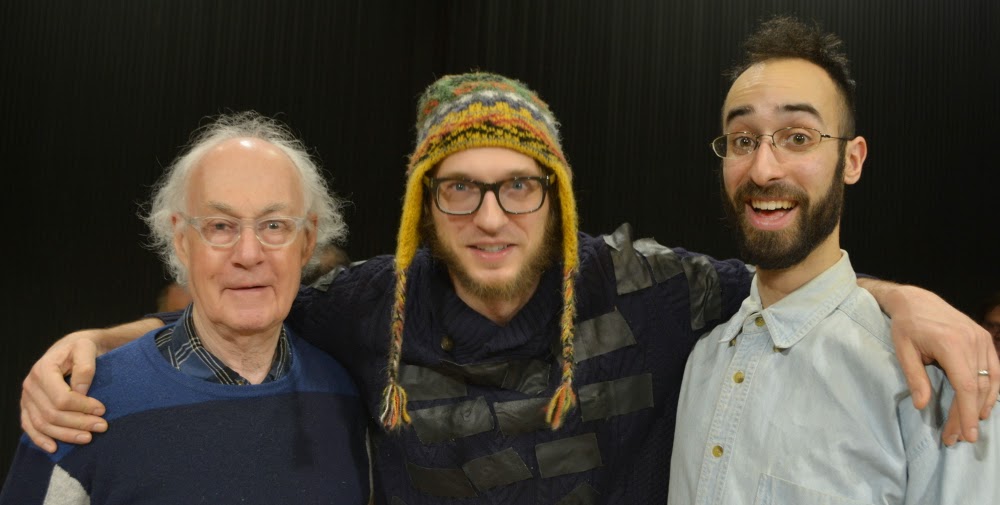Ron Kuivila masterminded the conference, coining its name, that simply implies a history of DIY synthesizers and the motivations behind them. I get in trouble with myself for the word DIY, but pressing on: David Tudor built many aluminum anonymous boxes; Michael Johnson of Pittsburgh and also You Nakai have been painstakingly understanding them. Thanks be to Ron for bringing these good friends here.
 |
| Ron Kuivila, You Nakai, Matt Wellins, Peter B, Michael Johnsen, Jonathan Zorn |
I've always been inspired by Michael's sound work, his corky attitude, and also smugly satisfying vintage encasures for electronic anonymoids not unlike the Tudors. He's said many sayings, such as "I don't need to buy any electronic components, since I could find anything I need in the trash," and "Tudor's boxes won't really work in anyone else's music, but work well in his own; this is a perfectly good reason for making one's own circuits."
Over South Indian vegetarian pastries, south of the cold town, Michael mentioned a factoid: that cabbage, brussels sprouts, and broccoli all have the same genetic code. This thought had been the center of many of mine own meditations, and so I quickly added: they are like different samples in the same sampler. Or more to the analog community: different sequences in the same sequencer. The apparatus is the same, but the plant can shift phases in a volatile code space- the cabbage way.
Michael inspires Matt Wellins, who after last night's concert is top on my list of electronic musicians. Matt did intern to me once, truth be told, but truth be told that he didn't learn anything from me. I had nothing but soldering iron gossip to offer. Michael gave him much more circuit sage, plus a plethora of pith. Matt went on to build some of his own boxes, very much in the same vein as the Tudor idiosyncratic style, explicitly for his own music.
 |
| Peter B, Matt Wellins (in action) |
My friend from Baltimore, Caleb Johnston, once offered a rubric for evaluating an experimental or noise performance. The simple trick is that you can make a sound only once. If you repeat it, for example in a looper or a sampler, then it's not memorable. Matt demonstrated mastery of the "one-sound" style last night, with his boxes that simply received knob twiddles to change continuously through a spectrum of previously unknown toot-plasts. The animal was well modeled by his cords.
Michael also modeled some animals, but a more literal picture projected into my acousmatic cortex. I first heard the sound of snow-locked groundhogs in their caves here on Brainerd Avenue, their hisses, chews and brain patterns as resonant dust. Next though, I heard some wind chimes, and finally a large man yelling at his dog. Realizing that Michael was painting my neighbors, I almost heard their little girls running in the yard. I offer another rubric for electronic performance evaluation: the ability to model one's neighbors as heard by an underground animal.
Neither of these artists would use a sampler or sequencer, for deep aesthetic reasons. They choose to pursue these animal modelings by a more natural, neuronal technique of feedback; a multiplicity of nodes each contribute phases and non-linearities to the limping throbbing whole. A rejection of the cabbage way: none of its volatile memory but instead connections make the brain.
I was very sleepy at the event, and at one point I awoke from snoring to hear four men bustling on the performance floor, talking in a semi-hush, while heterodyne whines pumped quietly from the house. You see, the final performance was a re-enactment of David Behrman's "Runthrough" on the original equipment, that requires a little bit of loving to work. Like the theme of the conference, David built his boxes as an esoteric object not for others to understand, but for others to hear. It was nice he shared it, and equally nice that the performance had a sort of kitchen prep as the new stewards- Ron, Michael, Jonathan- chopped onions and warmed up on the oscillators.
 |
| David Behrman, Peter B, Ron Shalom |
No comments:
Post a Comment